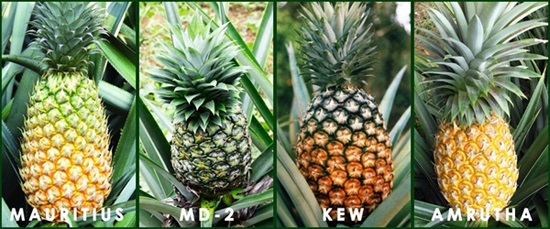
In international trade, the numerous pineapple (Ananas comosus) cultivars are grouped in four main classes: 'Smooth Cayenne', 'Red Spanish', 'Queen', and 'Abacaxi', despite much variation in the types within each class.
Smooth Cayenne or Cayenne ('Maipuri', 'Kew', 'Sarawak', 'Esmeralda', 'Claire', 'Typhoon', 'Saint Michel'):
Smooth Cayenne is extensively cultivated in Hawaii, Philippines, Australia, South Africa, Puerto Rico, Kenya, Mexico, Cuba and Formosa. The ovoid medium-sized fruit (1.5 to 2.5 kg) of 'Smooth Cayenne' is held on a short and strong peduncle. It ripens progressively, turning yellow from the base to the top, which is reflected in a strong internal maturity gradient too. The flesh is firm, close-textured, juicy and with a pale-yellow to yellow colour at maturity. And average acid range lies between 0.5 and 1.0% and total soluble solids (TSS) between 12° and 16° Brix. The plant is a poor producer of shoots and slips. The production cycle is longer than for most other cultivars. 'Smooth Cayenne' is sensitive to many known pests (fruit borers, mites, symphillids, nematodes) and diseases (mealybug wilt, fusariosis, fruitlet core rot, butt rot), and to internal browning. However, it is considered tolerant to Phytophthora sp. and resistant to fruit collapse, caused by Erwinia chrysanthemi Burkbolder.
Mauritius
Mauritius is recommended for commercial cultivation for table purposes and distant marketing, due to its shorter duration, better fruit quality, keeping quality and transportability.
Vazhakulam pineapple
Vazhakulam pineapple locally known as ‘Kannara’ belongs to Queen Cultivar (Mauritius) suited for table purpose. The average fruit weight is 1300-1600gms. The fruit is having a pleasant aroma, have a slightly conical shape, fruit ‘eyes’ deeply placed, fruit flesh is crisp and golden yellow in colour, juice is sweet with 14-16 o brix and its acidity is 0.50 - 0.70%. It is a good source of carotene, vitamins minerals and energy.
Amritha
It is a hybrid between Kew and Ripley queen. It has spiny leaves and 13-15 months duration. Fruit is cylindrical, tapering slightly from near base, weighing 1.5-2.0kg. Crown is small weighing 80-100g; ratio of fruit weight to plant weight is medium. Fruit is green when unripe and uniformly yellow when ripe; fissure and eye corking absent, spirals are left oriented. Fruit is firm with mild external aroma, skin 6 mm thick, flesh firm, non-fibrous, crisp and pale yellow in colour with rich aroma. Taste is good with high total soluble salts and low acidity.
MD-2
MD-2 is a hybrid pineapple originated in the breeding program of the now-defunct Pineapple Research Institute in Hawaii, which conducted research on behalf of Del Monte, Maui Land and Pineapple, and Dole. Two similar seedlings, numbered 73-114 and 73-50, were found to have bright-gold, very sweet, low-acidity flesh, high resistance to parasites and internal rot, skin that turned amber when ripe and, best of all, the ability to survive cold storage for up to two weeks. The Pineapple Research Institute, Hawaii was dissolved in 1986 and its assets were divided between Del Monte and Maui Land and Pineapple. Del Monte took 73-114, which it dubbed MD-2, to its plantations in Costa Rica, found it to be well-suited to growing there, and launched it publicly in 1996. In 1997, Del Monte began marketing its Gold Extra Sweet pineapple, known internally as MD-2. Del Monte also began marketing 73-50, dubbed CO-2, as Del Monte Gold.
MD-2 or Dinar pineapple is the standard for the international market because of its colour, flavour, shape, lifespan and ripeness. The commercial cultivation of MD-2 variety of pineapple was started in Central and South American countries during 1996. But at present it has occupied 50-55% of world market and 70-75% of European market in fresh pineapple. This is due to its excellent fruit qualities like high brix value (17 for ripe fruit), low acidity (0.4-0.45%), medium fruit size (1.5 to 2.0 kg), cylindrical shape with square shoulder, small core size, resistant to internal browning, very long shelf life (about 30 days) etc. The most important fruit qualities of MD-2 are its long shelf life and cylindrical shape. Instead of just 21 days for the normal varieties, it has 30 days of shelf life and is able to survive in cold storage for up to two weeks. By the 12th month, it can be plucked. MD-2 is resistant to internal browning, but susceptible to fruitlet core rot, and more sensitive to Phytophthora than Smooth Cayenne/Kew. MD-2 variety fetches a premium price than other varieties. Hence MD-2 will be the best pineapple variety that can be imported for cultivation in Kerala which will increase the export share of the pineapple produced in the state. IPR rules are not applicable to MD-2 variety as it is not a patented variety. MD-2 variety can be imported from Costa Rica, Ghana, Cuba, France etc. MD-2 performance evaluation is in progress at the Pineapple Research Station.
Ornamental pineapple
Ornamental pineapple (Ananas nanas) is also very popular among the gardeners and landscapers. It has very beautiful flower heads and reddish foliage.
Important varieties cultivated in different states of India are given below :
|
State |
Varieties mostly grown |
|
Assam & other N.E. states |
Kew, Queen, Mauritius |
|
Kerala |
Mauritius, Kew, Queen |
|
West Bengal |
Giant Kew, Queen |




